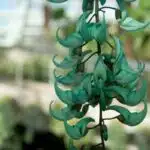Are you feeling lost and confused, trying to figure out how to grow a Jade Pothos (Epipremnum aureum ‘Jade’)? Don’t worry, you’re not alone! With the overwhelming amount of advice available on the internet, it can be difficult to know where to start. But fear not; we’ve got you covered! This article will provide you with all the tips and tricks that you need in order to cultivate this beautiful houseplant successfully.
As a specialist in botany and gardening, I can tell you that Jade Pothos is an easy-to-care-for perennial vine that’s perfect for brightening up any indoor space. Its glossy green leaves are sure to bring energy and life into your home or workspace. You don’t need an extensive knowledge of plants or gardening; just some basic instructions and the right care routine.
In this article, we will discuss all the necessary information required in order to properly care for your Jade Pothos. We will take a look at suitable potting mixes, watering requirements, proper light levels, temperature considerations, fertilizing schedules, pruning techniques and more. In addition, we will share some helpful tips on how to prevent common pests like mealybugs from attacking your plant. By the end of this guide, you’ll feel confident enough to become an expert Jade Pothos grower!
Overview Of Jade Pothos
The Jade Pothos is an elegant and versatile climbing plant, with its deep green leaves that cascade in graceful arcs. It is an easy to grow, hardy houseplant, perfect for those who want to bring a touch of nature into their home.
As a specialist in botany and gardening, I’m here to guide you through growing Jade Pothos. With the right conditions and care, your house will be filled with lush foliage and vibrant colour in no time.
Jade Pothos are best suited to bright indirect light, so it’s important to find the best spot for your plant. Provide enough light for it to thrive without too much direct sun which can scorch its delicate leaves. To ensure your plant gets exactly what it needs, keep an eye on the leaves – when grown in ideal conditions they should be glossy and vibrant!
Light Requirements For Jade Pothos
The lush foliage of the jade pothos, also known as epipremnum aureum, is an alluring sight for any plant enthusiast. Its variegated and heart-shaped leaves make it an ideal choice to add some vibrancy to any home or office space. Let’s dive deeper into what kind of light this houseplant needs to thrive and reach its full potential:
Light is one of the most important factors in terms of getting your jade pothos right. Here’s what you need to know:
- It needs bright, indirect light – preferably no more than 6 hours of direct sunlight, which can burn its leaves
- Jade pothos prefers high levels of humidity but will still do alright in normal household humidity
- Use fluorescent lighting if growing indoors; this helps with the variegation of the leaves
- Move it around for even growth; it shouldn’t be stuck in one spot for too long
Taking care of your jade pothos doesn’t have to be complicated if you know what requirements it has for light and humidity. With appropriate light conditions, your beloved houseplant will stay healthy and grow happily for years to come! Now let’s look at how temperature and humidity play a role in keeping your jade pothos happy…
Temperature & Humidity For Jade Pothos
Temperature and humidity are important considerations when growing Jade Pothos (Epipremnum aureum ‘Jade’). This warm-weather vine prefers temperatures between 70°F (21°C) during the day and 60°F (15.5°C) at night. It can tolerate lower nighttime temperatures for short periods, but it is not cold hardy. Additionally, regular misting of the foliage is recommended to increase its humidity.
Humidity should be kept within 50-70 percent, although higher levels won’t hurt the plant as long as adequate air circulation is provided. If your home’s humidity drops below 40%, you can use a humidifier to help keep the level up. You may also want to consider grouping your plants together to create a mini-greenhouse effect that will help keep their environment moist.
When it comes to caring for Jade Pothos, temperature and humidity both play important roles in keeping the plant happy and healthy. With proper care and attention, this beautiful vine can be enjoyed for many years to come! Next we’ll discuss water requirements for Jade Pothos so you can keep it looking its best.
Water Requirements For Jade Pothos
Watering your jade pothos is like walking a tightrope – too much and the plant will drown, but too little and it will suffer. Properly managing your jade pothos’ water intake is essential to ensure its health.
When it comes to watering, the rule of thumb is to give just enough to keep the soil lightly moist. Avoid overwatering as this can cause root rot and other fungal diseases. When watering, make sure that you are saturating the soil evenly with enough water for it to reach the bottom of the container. It’s best to let your jade pothos’ soil dry out slightly between each session of watering. You can do this by sticking your finger into the potting mix or using a moisture meter to check if it needs more water or not.
Similar to humidity levels, you should avoid drastic changes in water intake as well. Your jade pothos prefers consistency when it comes to its water requirements so try not to let them go too long without watering or don’t drown them in too much water either!
TIP: If you want an easy way to tell if your jade pothos needs more water, check the leaves for signs of wilting – if they look droopy then it’s time for a drink!
Soil & Fertilizer Requirements For Jade Pothos
As we look at the requirements for growing jade pothos, soil and fertilizer are essential components. As with any plant, the right soil composition and fertilization will help ensure healthy growth and longevity.
When it comes to soil, it’s important to choose a well-draining potting mix for jade pothos. This could include equal parts of perlite and peat moss or equal parts of perlite and compost. It’s also best to avoid using garden soil as it can be too dense and retain too much water.
When it comes to fertilizing, you should do this about once a month during the active growing season (spring through fall). Use a balanced liquid fertilizer that is diluted to half strength. You may also want to add some slow-release pellets when repotting your plant in springtime.
These tips will help ensure your jade pothos has all the nutrients necessary for healthy growth. Now let’s explore how pruning and propagation can be used to keep your plant thriving.
Pruning & Propagation Of Jade Pothos
According to the American Society for Horticultural Science, over 1.2 million houseplants are sold annually in the United States. Jade pothos (Epipremnum aureum ‘Jade’) is one of the most popular houseplants due to its easy care requirements and ability to thrive in low light conditions. Pruning and propagation are two essential tasks for caring for jade pothos that will keep it looking healthy and vibrant:
• Trim off brown or yellowed leaves as they appear, which helps reduce pest populations and makes the plant look neater. • Pinch back long vines to increase branching and encourage fuller growth. • Propagate new plants by taking stem cuttings from existing plants and planting them in water or soil. • Prune back overgrown stems periodically to promote bushier growth.
These steps can be performed at any time during the growing season, but should be done carefully with sterile tools to avoid damaging the stems or roots of your jade pothos. With regular pruning and propagation, your jade pothos will stay healthy while maintaining its beautiful appearance! Additionally, monitoring for pests and diseases is an important part of keeping your plant looking its best.
Pests & Diseases Of Jade Pothos
Pests and diseases can have a significant impact on the health of your Jade Pothos, so it pays to be aware of what to look for. In particular, fungal and bacterial infections such as root and stem rots are common in tropical climates. These can be identified by discoloration, wilting leaves, or soggy roots. Keeping the soil moist but not wet is important, as well as ensuring there is good air circulation around the plant. Additionally, scale insects and aphids may attack the foliage of your Jade Pothos if they become stressed or weakened. Regularly inspecting the foliage for signs of pests is an important preventive measure.
In order to control any pest infestations, you can use horticultural oils or insecticidal soaps. It is also advisable to quarantine any newly purchased plants in order to check for pests or disease before introducing them into your collection. Finally, encouraging beneficial insect populations such as ladybugs will help reduce the numbers of destructive pests in your garden.
By being vigilant about keeping an eye out for signs of pests and disease, you can ensure that your Jade Pothos stays healthy over time. This way you can enjoy its lush foliage without worrying about damage from unwanted visitors. With careful attention and management practices in place, now it’s time to explore container options for Jade Pothos.
Container Options For Jade Pothos
When it comes to growing jade pothos, container options are essential. With the right type of pot and soil, you can ensure your jade pothos has the best environment in which to thrive. As a specialist in botany and gardening, I’m here to share my expertise on choosing the right container for your jade pothos.
Firstly, it’s important to think about drainage. Jade pothos does not like sitting in wet soil for long periods of time, so make sure you choose a pot with plenty of drainage holes. Clay or plastic pots are two great choices; however, if your pot is made from something porous like wood or ceramic, you’ll need to line it with a plastic bag before filling it with soil.
Secondly, when considering the size of your pot, keep in mind that jade pothos will eventually become quite large if given enough space. Aim for a pot that’s at least 12 inches wide and 10 inches deep; this should provide enough room for several years of growth while still allowing adequate drainage. Additionally, if possible try to find one with an internal saucer as this will help prevent excess water from spilling onto surfaces below.
Finally, when selecting a soil make sure it’s well-draining and rich in organic matter. A soil mix designed specifically for succulents or cacti is ideal because these plants require excellent drainage and air circulation around their roots. You may also wish to add some slow-release fertilizer that’s been specifically formulated for houseplants in order to give your jade pothos a boost.
With these tips in mind you’re now ready to get started on finding the perfect container for your beautiful jade pothos! Best practices for growing this plant will be discussed next so sit back and enjoy learning how to give your jade pothos the care it deserves!
Best Practices For Growing Jade Pothos
Growing a Jade Pothos is not too difficult, but there are some important best practices to keep in mind. It is important to provide the right environment and care for this plant in order to maximize its growth potential. Here are some tips that will help you get the most out of your Jade Pothos.
First, it’s essential to give your Jade Pothos plenty of sunlight. Place it in a south or east facing window so it can receive at least 6 hours of direct light every day. If you don’t have enough natural light available, you can also use grow lights to supplement your lighting needs.
Second, the soil for your Jade Pothos needs to be well-draining and slightly acidic. A mix of two parts potting soil and one part perlite is perfect for this plant. You should water your plant deeply when the top inch of soil is dry and avoid overwatering it; if you notice any signs of soggy soil or root rot, adjust your watering schedule accordingly.
Third, fertilize your Jade Pothos every two weeks during the growing season with a balanced liquid fertilizer diluted to half strength. This will ensure that your plant has all the nutrients it needs to thrive. Keep an eye out for fertilizer burn by flushing out excess fertilizer from the soil if necessary.
With these best practices for growing Jade Pothos, you should be able to enjoy this beautiful houseplant for years to come! Next up, we’ll discuss common problems with Jade Pothos and how to address them effectively.
Common Problems With Jade Pothos
Do you know what common problems can affect your Jade Pothos (Epipremnum aureum ‘Jade’)? As an expert botanist and gardener, I want to help you understand the potential issues and how to address them. Here are some of the most common problems that can occur:
Poor Drainage: Poor drainage can lead to root rot in your Jade Pothos and is one of the most common issues. To prevent this, make sure your soil has good drainage before planting, or use an elevated container with holes in the bottom for water to drain out.
Overwatering: Too much water can cause root rot and other issues, so it’s important to be careful with your watering schedule. Make sure to only water when the top 1-2 inches of soil is dry and keep an eye on the leaves for signs of overwatering such as yellowing or wilting.
Not Enough Light: Without enough light, Jade Pothos will struggle to thrive. Place your plant near a south-facing window for best results or supplement natural light with a grow light if necessary.
These are just some of the potential problems that can arise when growing Jade Pothos. With proper care and attention, you can avoid these issues and get the most out of your plant!
Troubleshooting Tips For Jade Pothos
Jade Pothos (Epipremnum aureum ‘Jade’) is a popular houseplant because of its hardiness, low-maintenance care, and ability to fit in almost any space. It’s important to troubleshoot any issues that arise with jade pothos in order to keep them healthy and thriving. Here are some tips for successfully troubleshooting common problems:
- Brown or yellow leaves – This indicates a nutrient deficiency and can be corrected by applying fertilizer according to the package instructions.
- Wilting leaves – This could be due to either underwatering or overwatering. If overwatered, let the soil dry out before watering again; if underwatering, increase watering frequency based on the climate of your home or office.
- Sticky leaves – This is usually caused by an insect infestation such as aphids or mealybugs. Treat the plant immediately with an appropriate insecticide according to instructions on the label.
- Unhealthy stems – Check for pests such as scale insects or spider mites and use an appropriate pesticide if needed. Prune off any dead stems that are not producing new growth and repot with fresh potting mix if necessary.
By being proactive about these potential issues, you can ensure your jade pothos stays healthy and vibrant for many years. With appropriate care and troubleshooting, your jade pothos will continue to thrive even during winter months when temperatures drop significantly…
Caring For Jade Pothos In Winter
Caring for Jade Pothos in winter can be a challenge, but with the right steps and knowledge, it’s easy to ensure your plants stay healthy and thriving. Winterizing your Jade Pothos is essential to ensuring that it continues to look its best and enjoy steady growth. Here are some tips on how to take care of your Jade Pothos during the colder months.
First, reduce the amount of water you give to the plant during winter by half. This will stop root rot from occurring due to over-watering while ensuring that it still receives enough moisture for photosynthesis. Furthermore, decrease fertilization as well; any fertilizers should be nitrogen-heavy as this will help keep the leaves vibrant and healthy throughout winter.
Second, make sure that you provide adequate light for your Jade Pothos during winter. While leaving them outside is not recommended in cold climates, giving them access to a bright spot such as a sunny windowsill can help get it through the season without any issues. Lastly, keep an eye out for pests or diseases; although rare, they may still occur due to improper maintenance or sudden changes in temperature.
These simple steps will go a long way towards keeping your Jade Pothos looking lush and vibrant all year round! With these precautions in place and proper maintenance, you’ll be able to enjoy this beautiful plant season after season. As we move into springtime, we can reap the rewards of successful winter gardening with our beautiful Jade Pothos plants on full display – ready to welcome a new season of growth!
Benefits Of Growing Jade Pothos
Jade pothos (Epipremnum aureum ‘Jade’) is an evergreen climber that is prized for its beautiful foliage and easy care requirements. In addition to its attractive features, jade pothos also has some beneficial qualities that make it a great choice for any gardener.
One of the most rewarding benefits of growing jade pothos is its ability to purify air in indoor spaces. Studies have shown that jade pothos can reduce toxins such as formaldehyde, benzene and trichloroethylene in the air we breathe. It’s a great natural way to improve your home’s air quality and create healthier living conditions.
Jade pothos plants are also known for their low maintenance care requirements. They can tolerate a wide range of temperatures, from 40-90 degrees Fahrenheit, and don’t require much pruning or repotting. Plus, they’re incredibly drought tolerant making them well-suited for beginner gardeners who may not have experience caring for plants.
As you can see, there are many advantages to adding jade pothos to your home or garden space. Whether you’re looking to improve the air quality in your home or simply add some greenery without too much effort, jade pothos is an excellent choice with numerous benefits. With proper care and attention, this plant will thrive indoors or outdoors and bring beauty into any room in your house.
Tips For Purchasing Jade Pothos
The purchase of Jade Pothos (Epipremnum aureum ‘Jade’) is an important step in its care and growth. To ensure the best possible outcome, here are some tips to consider when buying this beautiful houseplant:
Look for plants that have lush green foliage with no signs of yellowing or wilting. This indicates that the plant is healthy and has been well cared for.
Inspect the roots for signs of rot, as this can drastically reduce the life expectancy of Jade Pothos. If the soil appears to be too wet or compacted, it is best to look elsewhere.
Make sure the pot size is appropriate for the amount of foliage present, as an undersized pot can lead to stunted growth. Additionally, check that there are drainage holes in the bottom to prevent root rot from overwatering.
Consider purchasing multiple plants if possible, as Jade Pothos grows quickly when given sufficient light and air circulation. The more plants you buy, the faster your collection will grow!
By following these tips when purchasing Jade Pothos, you can ensure that your new houseplant will thrive in its new home and bring years of enjoyment. With proper care and maintenance, this resilient species can become a beautiful addition to any garden or living space. As with any houseplant purchase, it pays to be informed before buying and to get advice from experienced growers if needed. With these considerations in mind, you are now ready to learn some fun facts about Jade Pothos!
Fun Facts About Jade Pothos
Interestingly, it has been estimated that there are almost 500 species of the ‘Epipremnum aureum’ plant family. Of these, the ‘Jade Pothos’ is one of the most popular varieties in home gardening. As an experienced botanist and gardener, I am here to discuss some fun facts about it to make your growing experience more enjoyable.
Firstly, it is important to note that the Jade Pothos is native to tropical parts of Southeast Asia and Australia. Its vibrant green leaves have earned it the nickname ‘Money Plant’, as they resemble coins. This makes them popular with houseplant enthusiasts due to their ability to bring good luck and fortune!
Besides its attractive foliage, this plant is also renowned for its hardiness and ease of growth. It can survive in low light conditions and occasional neglect making it a great choice for busy gardeners or those just starting out in horticulture. Additionally, this plant does not need much pruning or fertilizing – which makes it a great option for those looking for an easy care houseplant.
In addition to being easy-care, Jade Pothos is also renowned for its air-purifying properties. With proper ventilation and regular watering, this houseplant can help remove toxins such as formaldehyde from your indoor environment – making it both aesthetically pleasing and beneficial to your health!
Frequently Asked Questions
How Often Should I Repot My Jade Pothos?
“The early bird catches the worm,” an adage that is as true in gardening as it is anywhere else. When it comes to repotting your jade pothos, this old saying applies just as much. Repotting is an important part of caring for your jade pothos and should be done at least once every two years. It’s best to err on the side of caution and not overpot or underpot your plant; a pot that’s too big can cause root rot, while one that’s too small won’t allow enough room for growth.
When you’re deciding when to repot your jade pothos, consider the size of the pot and the age of the plant. If you’ve had your plant for a few years and its roots are growing out of the drainage holes or pushing up against the sides of the pot, it’s time to move up to a larger pot. If you’ve just purchased a new jade pothos, wait until late spring or summertime before you start repotting it; this will give it plenty of time to acclimate itself to its new home and adjust to its environment before going through any more changes.
Before repotting, be sure to choose a pot with adequate drainage holes so excess water can escape and not cause root rot. You’ll also want to use a soil mixture specifically made for epipremnum plants; regular potting soil doesn’t have enough nutrients for them and may lead to nutrient deficiencies down the line. Once everything is ready, gently remove your jade pothos from its current pot and loosen any tangled roots before placing it in its new home. Water thoroughly but don’t overwater; let your plant rest for several days after repotting before fertilizing it again.
With regular care and attention, your jade pothos will thrive in its new home! Just remember: when it comes time to repot again, do so sooner rather than later for optimal success!
Is Jade Pothos Toxic To Pets?
The lush, vibrant foliage of the jade pothos (Epipremnum aureum) is an eye-catching addition to any home. This low-maintenance houseplant is as beautiful as it is easy to care for—but one important factor may be overlooked: its toxicity to pets.
Pets, such as cats and dogs, can be poisoned if they eat jade pothos leaves or stems. All parts of the plant contain needle-shaped calcium oxalate crystals that cause intense burning and irritation in the mouth and throat upon contact. Symptoms of poisoning include excessive drooling, vomiting, difficulty swallowing, and skin irritation from contact with the sap.
It’s important to keep your pets away from this houseplant. If you have any doubts about their ability to resist its temptations, place the plant out of reach in a hanging basket or on top of high shelves that your pet won’t be able to access. Also make sure to cover any exposed soil since ingestion of dirt can also lead to poisoning. TIP: To ensure safety for your pet and stress-free maintenance for you, use artificial plants instead of real ones! Not only are they pet-friendly but they’ll also last longer without requiring regular pruning or repotting.
How Often Should I Fertilize My Jade Pothos?
The jade pothos, with its vibrant emerald green and white variegated leaves, is an attractive houseplant that can be a source of pride for any gardener. Its ability to thrive in low-light conditions and low maintenance requirements make it a desirable addition for the novice or experienced gardener alike. When caring for your jade pothos, one of the most important things to consider is how often to fertilize.
Fertilizing your jade pothos should be done at least every two months during the spring and summer and then once a month during the fall and winter. To help ensure that your plant gets all the nutrients it needs, choose a balanced liquid fertilizer such as 10-10-10 or 20-20-20 and follow the instructions on the packaging for application. It’s important not to overfertilize your plant as this can lead to leaf burn or nutrient deficiencies.
When applying fertilizer, try to avoid getting it on the leaves of your jade pothos as this can cause damage. Carefully pour diluted fertilizer around the base of your plant twice per month during spring and summer, then once per month in fall and winter. Be sure to water regularly so that excess fertilizer doesn’t build up in soil over time. With proper care, you can expect your jade pothos to grow strong and healthy for many years to come!
Can I Grow Jade Pothos Indoors Or Outdoors?
Jade Pothos, also known as Epipremnum Aureum ‘Jade’, is an evergreen vine that can be grown both indoors and outdoors. It has a wide range of uses and provides a beautiful, lush green foliage to any environment. For example, let’s take the case of Bob who lives in a small apartment in the city. He wanted to add some greenery to his home, so he decided to grow Jade Pothos in his living room. Here are 3 key points you should consider when growing this plant:
Temperature: Your Jade Pothos needs temperatures between 18 and 30 degrees Celsius (65-86 F) for optimal growth. If your plant is kept too cold or too hot it can cause stunted growth or wilting leaves.
Humidity: The ideal humidity level for growing Jade Pothos is around 40-50%. If your home environment is dryer than this, you may need to mist your plant regularly or invest in a humidifier.
Light: Your Jade Pothos will do best with bright indirect light from a few feet away from a window or near an artificial light source like LED lights. Avoid placing them outside in direct sunlight as this can cause sunburn on the leaves and damage the entire plant.
When it comes to caring for your Jade Pothos, make sure you water it regularly and fertilize it every two weeks with liquid houseplant fertilizer diluted by half of its recommended strength. Additionally, trim off dead leaves as needed and repot into larger containers if necessary for proper growth development. With proper care, your Jade Pothos will thrive indoors or outdoors!
Does Jade Pothos Need Direct Sunlight?
Jade Pothos (Epipremnum aureum ‘Jade’) is an evergreen, trailing vine with beautiful foliage. It has become one of the most popular houseplants due to its easy maintenance and hardiness. Does jade pothos need direct sunlight in order to grow? It’s an important question for those wanting to give their plant the best environment possible.
Surprisingly, jade pothos can actually survive on low light levels. In fact, the American Society for Horticultural Science found that this plant thrived well in medium to low intensity lighting conditions – even growing five times faster than when exposed to strong sunlight.
For optimal growth, however, it is recommended that jade pothos should receive some bright indirect light daily. This will help the leaves remain dark green and vibrant looking throughout the year. Additionally, you may want to rotate your plant occasionally so that it receives even amounts of light from all sides of its stem. If you are growing this plant indoors, make sure to keep it away from windows as direct sunlight can scorch the leaves.
Overall, jade pothos does not necessarily require direct sunlight in order for it to thrive; however providing some bright indirect light throughout the day can certainly help encourage healthy growth and vibrant foliage colors.
Conclusion
Jade Pothos is a beautiful and easy-to-care for houseplant that can bring life to any space. With the right amount of sunlight, water, and fertilizer, it can quickly become an eye catching centerpiece in your home or office.
It’s important to remember that Jade Pothos is toxic to pets so it’s best to keep it out of their reach. Repotting should be done every 2-3 years, while fertilizing should be done monthly during the growing season and bi-monthly during winter. When kept indoors it should be placed in a spot with bright indirect light, but if kept outdoors it should have some protection from direct sunlight.
Overall, Jade Pothos is a hardy plant that offers lush green foliage for any space. With proper care and attention this plant can thrive for many years and will make an attractive addition to any home or garden.





























